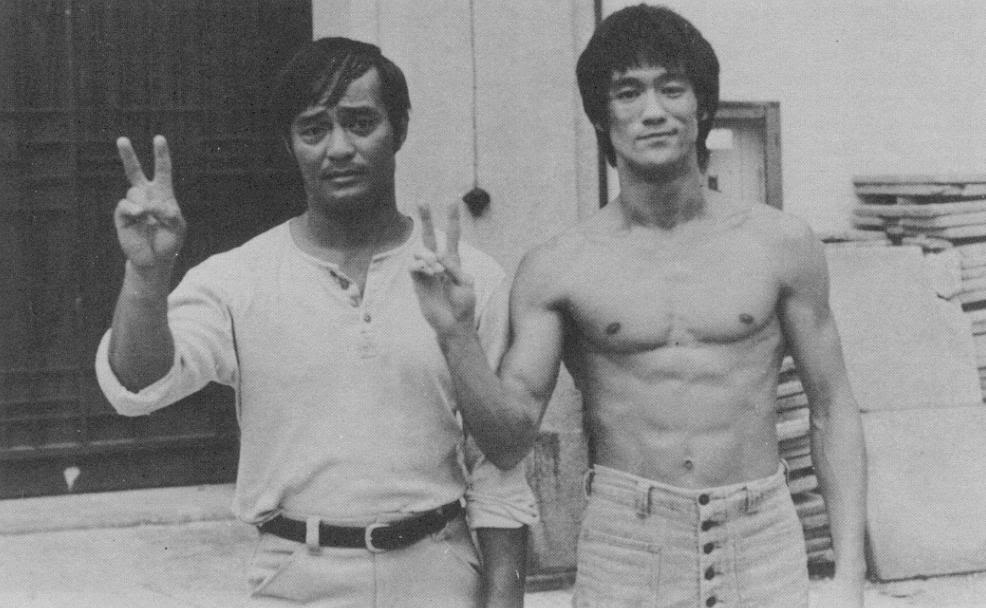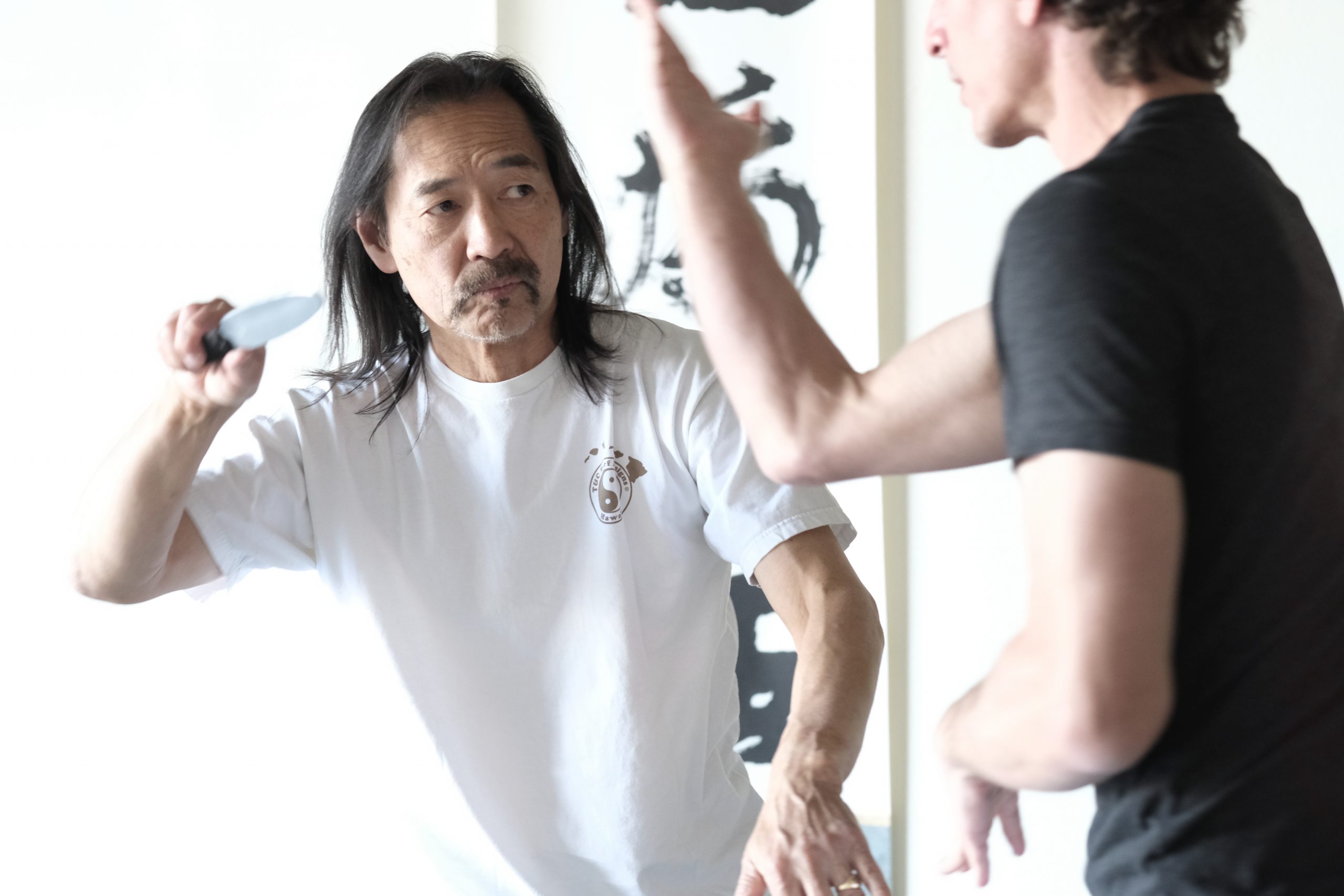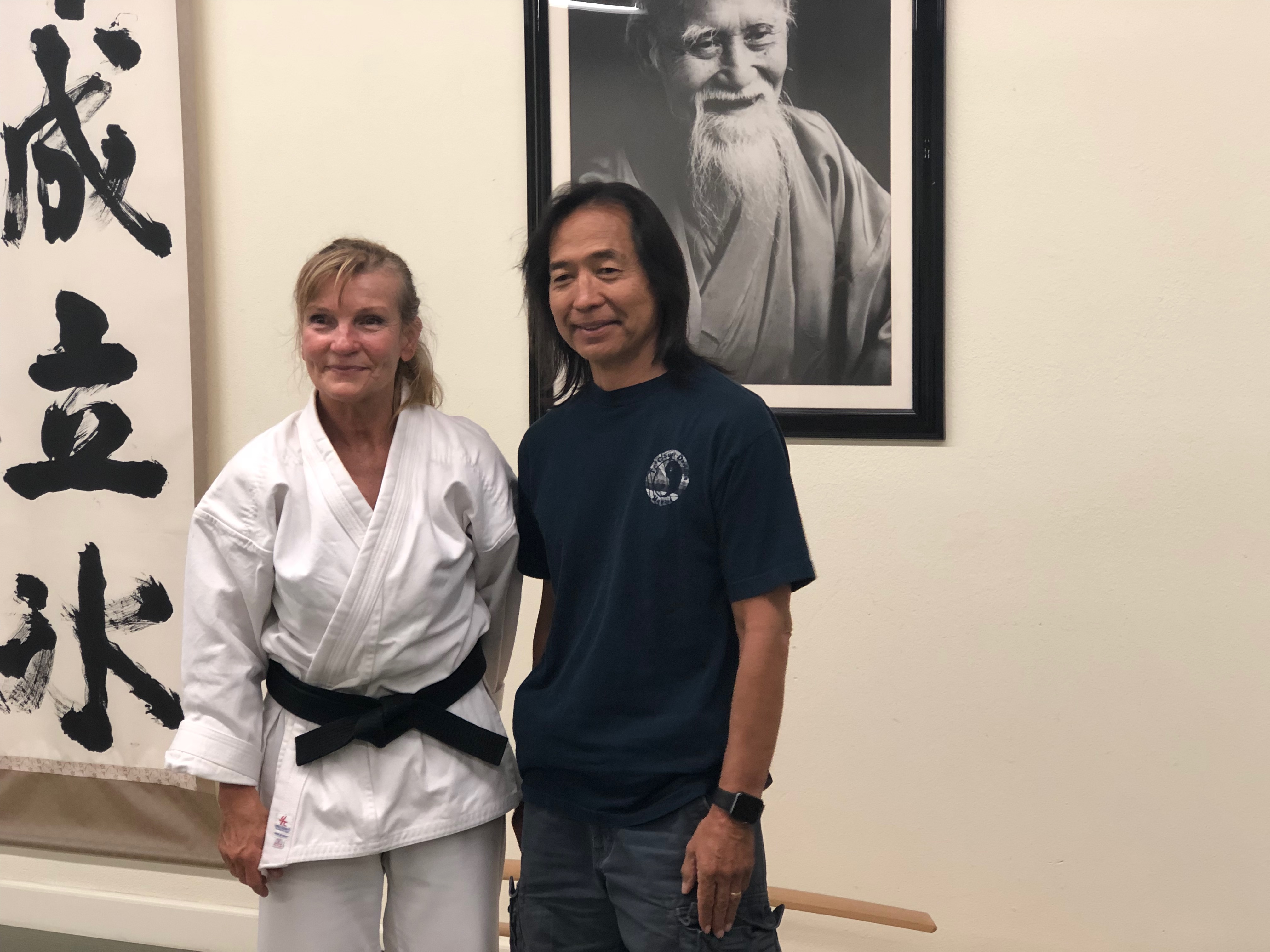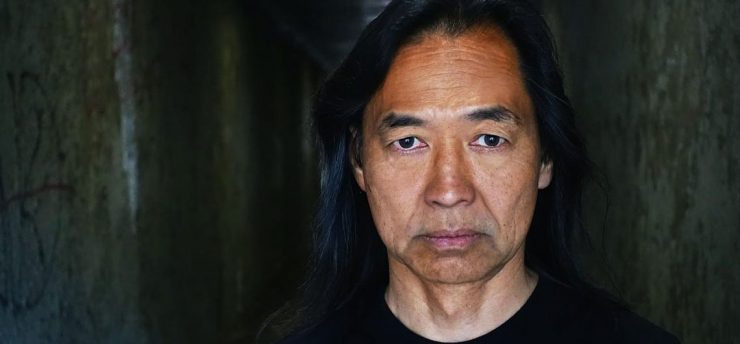On the early days of the Inosanto Academy
Jeff Imada is an American martial artist, Hollywood stunt and fight coordinator, 2nd unit director, and stunt performer. He is considered one of the most respected in the industry, with a resume that includes over 400 films and TV episodes. Imada’s best known work includes Furious Seven (2015), Hanna (2011), The Book of Eli (2010), The Bourne Ultimatum (2007) and The Bourne Supremacy (2004), Fight Club (1999), and LA Confidential (1997). Over the past thirty-eight years, he has worked alongside directors such as John Carpenter, David Fincher, and Curtis Hansen, and choreographed or appeared alongside Matt Damon, Colin Farrell, Brad Pitt, Forest Whitaker, Denzel Washington, Brandon Lee, Sylvester Stallone, Wesley Snipes, and countless others.
Imada was born and raised in Inglewood, California, where he began studying martial arts at the age of fifteen. He went on to attend UCLA, where majoring in pre-medicine and minoring in music, he began working as a film extra before becoming a member of the Screen Actors Guild and the highly regarded US stunt group, “Stunts Unlimited.” He has authored two books on the history and use of the Balisong knife, which includes The Balisong Manual (1984), one of the first books published in the US about this weapon. He also designed and manufactured the first US version of the telescopic baton. A true renaissance man – martial artist, instructor, stunt and fight coordinator, stunt performer, actor, director, author, musician –, Imada sat down with us to discuss his career, share his insights, and talk about his experience with Dan Inosanto and the Inosanto Academy of Martial Arts.

Josh Gold: Can you talk a bit about what it was like training when the Inosanto Academy of Martial Arts first started?
Jeff Imada: Actually, when it first started it was called the Filipino Kali Academy. Later, the name was changed to the Inosanto Academy. When Guro Dan and I talk about the early days now, he’ll say, “We were crazy back then! Today, we’d get sued!” Because in the Jeet Kune Do class, we were experimenting and sparring full-contact with weapons and there was hardly any protective gear for martial artists at that time– we’d all come in with our hodge-podge of different things that we’d find. Some guys would come in with hockey gloves to protect themselves, umpire or catcher shin guards, chest protectors, motorcycle gear, and stuff like that. That’s what you saw in Enter the Dragon (1973), the fruits of a lot of full contact sparring and experimentation with weapons that Bruce and Dan did. It was an exciting time and what made it work, I think, was that everybody really got along well. It was sort of funny, because we’d be hitting each other and we’d be apologizing at the same time. You’d be sparring and then bam! And then, “Hey, are you okay? Are you okay?” “Yeah keep going!” Nobody wanted to hurt anybody, but we all wanted to train hard.
“Shortly after meeting Dan, I was exposed to the Jeet Kune Do philosophy of ‘Absorb what is useful, reject what is useless, and add what is specifically your own.’ This resonated with me profoundly and I’ve been training with Dan ever since.”

So, yeah, we’d bring in whatever we could find in terms of protective gear and the same went for weapons. I wore thinner protective gear, because I was smaller and wanted to be able to move. So it was either mobility or protection when we were sparring full contact with staffs, and sticks, and different things. Since I opted to go lighter, so I could be a little faster than some of the bigger guys. Because at the beginning, a lot of guys were overprotecting themselves, it sort of defeated the purpose. It made them braver to fight, because when they’d get hit they wouldn’t feel anything. So Dan would have to tell some of the guys, “You have to strip down a little bit of that stuff so that it’s more realistic, because you’re just barreling in…”
…like RoboCop.
Exactly! The early 70s was an interesting time for us. You learned what weapons worked and what weapons didn’t. And some of the fancy stuff didn’t always work. We tried the nunchaku. Everyone remembers Bruce using them and they looked great on screen, but they weren’t high on the totem pole of go-to weapons because as soon as you break the momentum you’re at a disadvantage. We experimented with it, figured out how we could use it most efficiently, what its limits were. We experimented with a whole lot of different weapons.
When we’d spar with or without weapons, we’d do three-on-one fights, two-on-one fights, we’d turn off the lights, fight in the dark, we’d leave the door open just a sliver so we’d see shadows and silhouettes. We’d fight on different elevations where we’d spar or do kickboxing with weapons, somebody would stand on top of a table and somebody would be on the ground, or somebody would lie down and somebody would stand up. We tried all different types of environmental situations for sparring to see how we’d fare. We’d match up big guys with small guys, we’d make-up limits like a wounded arm or a wounded leg. It was a lot of exploration that way. It was quite a time period. The energy at the school was just unbelievable. You might go in after a rough day, and as soon as you walked in, you’d be hit with the energy of the place. We would focus on this stuff in the Jeet Kune Do class. The class would go until 10 at night, people would stick around talking, we’d decide to grab something to eat, then come back to the school after. It wasn’t uncommon to stay at the school until one o’clock in the morning. It was really quite appreciated and quite a special time then.
Because of Bruce’s popularity, a lot of people would come visit the school, want to meet Dan, see what we were doing. Consequently, there were a lot of different martial artists from different styles that would come and visit. Dan is very open, so a lot of the time, he would invite different instructors to do a seminar for the evening or just jump into the class. It was very much a place for a lot of different martial artists to come in and visit and feel comfortable, as long as they had a certain level of martial arts experience.

Soon enough, the school became a sort of melting pot through its exposure to different people. People from all over the United States, China, Europe, Indonesia, Japan, and other places would come over and visit. Over the years, there were maybe three or four different Wing Chun instructors, Tai Chi, Muay Thai, Savate, boxing instructors, and tons of different Filipino instructors. Some of them didn’t always get along at first. They’d come in with a very traditional mindset wanting to make sure that they were being respected in every way. But Dan was always so humble that everybody felt comfortable and ended up getting along really well. Instructors who normally wouldn’t talk to each other for whatever reasons were now speaking to each other because of the environment Dan created.
“It was quite a time period. The energy at the school was just unbelievable. You might go in after a rough day, and as soon as you walked in, you’d be hit with the energy of the place. “
The Academy was the center, it was the meeting point for martial artists from around the world who were all established in their respective martial arts. You’d meet other black belts, some of whom were well-known in the Karate circuit. They’d come in where we were fighting, with boxing gloves, sparring full contact. They would be blown away saying, “Wow, I just got hit three times, I’ve never been hit like that before, and I’m a third degree black belt!” It was definitely an eye-opener for most everybody. It was certainly a different way of learning.

At the time when we’re sparring, everybody had their own style of fighting. Some were quite unorthodox, but very effective. And the whole experience was so eye-opening to me. Being able to see the diversity and mixture of different styles, the different levels, the different ways people moved. We were encouraged to experiment and try different things to see if they worked or didn’t. I learned something early on that has really stuck with me: I realized it’s not about going toe-to-toe with somebody, rather it’s about finding a different path to survive, or to fit in, or even to be able to control the situation without having to fight. This early experience taught me that that’s the ultimate level: you don’t want to fight unless you absolutely have to. And if you do have to fight, you want to do it in a way that you don’t have to hurt the person. But, if you can nullify the situation without touching the person, without having any physical confrontation, then that’s the highest level of martial arts practice there is. A true martial artist doesn’t want to fight, you’re not out looking for a fight, but should you get into a fight, you want to finish it as quickly as possible so it doesn’t last, it doesn’t escalate, and you won’t be in jeopardy for very long.
“The Academy was the center, it was the meeting point for martial artists from around the world who were all established in their respective martial arts.”
So, yeah, thanks to Bruce’s fame, the JKD philosophy, and Dan’s openness with his knowledge, I was exposed to a lot of very good different martial arts and it was through this experience that I was taught this insight very early on. Back then, there’s no way I would’ve been able to see, work with, or even know about such diverse styles. It’s very different today, because the world is getting smaller and you now have easy access to information otherwise outside your reach. Back then, of course, the only way you could learn about an obscure martial arts style was to find books or travel there and search for it firsthand. Today, because you have YouTube and the internet, you can start to get an idea of different martial arts by watching people online. You may not be able to feel it, the person online may or may not being doing the art properly, but at least you can begin to get the idea.

That was a pretty unique environment in the 70’s. It sounds like you were part of a center of innovation, like Silicon Valley, but for the martial arts.
Yeah, pretty much. Dan had a philosophy that we should continue learning from other instructors. He’d regularly encourage us saying “You should all study from other people, don’t just study from me.” This was very much a non-traditional format. Back then, most schools discouraged this kind of study between different martial arts. When I was taking Tae Kwon Do, I also took up Kempo. I’d go from Kempo class directly to Tae Kwon Do class. On the way, I’d think to myself, “ Okay, now I’ve got to switch gears to the stances and postures for Tae Kwon Do instead of Kempo.” A couple times my instructor would ask me, “What style are you doing?! Stop that, you gotta quit that!” [laughs]. So even though I got busted, I was still interested in learning different things from different martial arts. Shortly after meeting Dan, I was exposed to the Jeet Kune Do philosophy of “Absorb what is useful, reject what is useless, and add what is specifically your own.” This resonated with me profoundly and I’ve been training with Dan ever since.













I am just not sure how this article relates to aikido at all…
I think loloy makes a good point in his comment below. Additionally, Stanley Pranin and Aikido Journal have a history of bringing perspectives from the broader martial arts world to the aikido community. In its 45 year history, AJ has interviewed practitioners of BJJ, Systema, Daito-ryu, various koryu, Judo, Sumo, etc. And as a further reason for us publishing pieces like this, there’s been a marked shift in the aikido community to become less insular and connect with and learn from practitioners in other arts. If it’s not your thing, no problem. Just skip over these pieces 🙂
It’s meant to give a different view to other arts. Not all arts are effective, not all aikido styles are effective.
Different view and perspectives enrich any martial style, if the art you like and practice has been learned correctly with principles, you will find these principles across other disciplines and their approach might help your own art grow.
I quote ” I realized it’s not about going toe-to-toe with somebody, rather it’s about finding a different path to survive, or to fit in, or even to be able to control the situation without having to fight. This early experience taught me that that’s the ultimate level: you don’t want to fight unless you absolutely have to. And if you do have to fight, you want to do it in a way that you don’t have to hurt the person. But, if you can nullify the situation without touching the person, without having any physical confrontation, then that’s the highest level of martial arts practice there is. A true martial artist doesn’t want to fight, you’re not out looking for a fight, but should you get into a fight, you want to finish it as quickly as possible so it doesn’t last, it doesn’t escalate, and you won’t be in jeopardy for very long.” I thought that was Aikido right there.